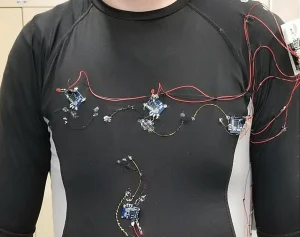A group of researchers in Canada have created a smart T-shirt capable of monitoring the breathing of the wearer, which could be useful for medical and athletic applications.
An advantage of the smart T-shirt is its ability to conform to different body types without restricting mobility or causing discomfort.
‘We believe that such technology will be very useful in hospitals, to reduce opioid overdose deaths, and prevent active people from overexertion,’ says Amine Miled, Associate Professor at the Department of Electrical and Computer Engineering at Université Laval in Quebec City, Canada.
The smart shirt was designed by Miled and his team, including colleagues Marc-André Dugas and Younès Messaddeq. It involves a network of thin, spiral antennas with Bluetooth capabilities embedded within the cloth. The antennas deform slightly as the wearer breathes in and out. A network of wireless sensors detect the deformations, and the data is wirelessly transmitted to a base station for analysis.
The researchers tested the smart shirt on volunteers and described the results in a paper published on the 28th of December in IEEE Sensors Journal.
In the course of the experiments, it became increasingly clear that people have much different breathing patterns, particularly among the sexes. Some people were more likely to breathe using their belly rather than their chest.
‘We anticipated this challenge because the body of each person is unique,’ said Miled. For this, the smart shirt was designed to ‘pick’ which of its six sensors—distributed across the upper and lower torso— is most accurate and effective for monitoring the breathing of the wearer.
According to Miled, several companies have declared their interest in this tech but more research and further steps need to be taken before it is commercialized.
‘The next step that is ongoing now is to compare our results with other approaches…and with the help of doctors, try to extract some breathing profiles of some common disorders,’ said Miled, stating that the shirt could already detect sleep apnea. ‘We are also able to detect a significant change in breathing amplitude, inspiration and expiration.’
By Marvellous Iwendi.
Source: IEEE Spectrum
